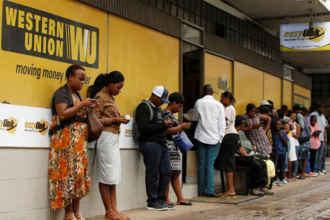- What are international payments?
- Differences between international and domestic payments
- Processing time
- Foreign currency exchange
- Foreign exchange risk
- Regulatory compliance
- Intermediaries
- Transaction charges
- Types of international payments
- Wire transfers
- Online payment platforms
- International money orders
- Foreign exchange brokers
- Cryptocurrency transfers
- What can you use international payments for?
- Challenges in international payments
- Best practices for managing international payments
- Understand local payment preferences
- Use efficient payment gateways
- Ensure compliance and security
- Optimize for mobile payments
- Provide transparent pricing and fees
- International payments FAQ
Are you ready to take your business global? There’s a laundry list of things to do to prepare for cross-border commerce. Arguably, the most important part is your international payment setup: how you’ll get paid from foreign customers or pay international suppliers.
In this article, you’ll learn how international payments work, how they differ from domestic payments, and how to minimize payment fees.
What are international payments?
International payments are financial transactions where the person sending the cash and the person receiving the cash are in different countries. International payments are also known as cross-border payments.
Businesses use international payments to expand their market reach and manage their global supply chain. That might involve sourcing inventory from Hong Kong or expanding a customer base by selling to customers in Singapore.
International payments often involve the conversion of one country’s currency into another. For example, a US-based ecommerce store that sells in Singapore needs an international payment option that converts the US dollar to the Singapore dollar.
Differences between international and domestic payments
Domestic payments and international payments are similar because they both involve the transfer of funds from one party to another. But the similarities end there. Here are some key differences between international payments and domestic payments:
- Processing time
- Foreign currency exchange
- Foreign exchange risk
- Regulatory compliance
- Intermediaries
- Transaction charges
Processing time
Domestic payments are faster than international payments because they use a simpler infrastructure within a single country’s financial system. You can transact between banks with established relationships, eliminating the need for intermediary banks often used for international money transfers.
Domestic payments also deal with the same currency, eliminating the need for conversion. This requires less scrutiny for money laundering and illicit transactions.
Foreign currency exchange
Domestic payments are made in a single currency and don’t involve currency conversion. However, international payments often involve at least two currencies, requiring currency conversions. These currency conversions take time and money. Banks will typically use a real-time mid-market exchange rate and then add on markup for their profit.
Foreign exchange risk
Currency conversion in international payments comes with foreign exchange risk (FX risk). FX risk is the chance of losing money when converting currency because of exchange rate fluctuations.
Suppose your ecommerce company owes a Japanese supplier 1,000 yen for inventory you ordered last month. When you placed the order last month, the exchange rate was $1 = 100 yen. Therefore, you owed $10 (¥1,000 ÷ ¥100) last month.
But instead of paying the supplier last month, you’re paying today. And the exchange rate is $1 = 95 yen. Now you’ll owe $10.53 (¥1,000 ÷ ¥95). Waiting a month to pay your supplier costs you an additional $0.53.
On the other hand, you could save money with FX risk. Assume that today’s exchange rate was $1 = 110 yen. You would pay $9.09 (¥1,000 ÷ ¥110), saving $0.91.
Regulatory compliance
While local regulations govern domestic payments, international money transfer is governed by the rules of the originating country and the receiving country.
Countries can have different compliance requirements for:
- Anti-money laundering
- Customer due diligence, also known as Know Your Customer (KYC)
- Imposed sanctions
- Tax reporting
Intermediaries
Domestic payments often involve just two banks in the same country: the sending and receiving banks. International payments, however, involve banks from multiple countries that aren’t directly connected. Intermediaries bridge this gap. They include correspondent banks and intermediary banks that ensure recipients receive funds in their local currency.
The drawback of intermediaries is that they slow down processing times, increase costs, and may lack transparency on exchange rates used and fees charged.
Transaction charges
Domestic payments are often cheaper than international payments. Examples of charges for international payments are:
- Transaction fee from your bank
- Intermediary bank fee
- Foreign exchange fee markup
- Wire transfer fee
Types of international payments
| Wire Transfer | Online Payment Platforms | Money Orders | FX Brokers | Cryptocurrency | |
|---|---|---|---|---|---|
| Cost | High fees | Fees vary but are lower than wire transfers | Currency conversion fee and issuance fee | Commission fee and markup on exchange rate | Transaction fees vary by currency |
| Transaction Limitations | No fixed upper limit | Varies depending on user verification status | Lower transaction limits | Ranges from a few thousand to millions | Limits vary by platform |
| Speed | Often completed the same day or the next | Quicker than money orders, but slower than wire transfers | Can take several days or even weeks | Can be faster than wire transfers | Some cryptocurrencies can process transactions in minutes |
| Special Requirements | Recipient’s bank account information | Account creation is required, and a bank account or credit card may be linked | Must visit a physical location and fill out a form | Large transactions may require additional documentation | A cryptocurrency wallet and an understanding of cryptocurrency transfers |
| Security | Bank-level encryption | Robust security measures, but vigilance is still important | Anyone with a money order can cash it | Considered secure due to broker regulations | Considered high risk |
Wire transfers
A wire transfer is an electronic payment that moves money from one bank account to another. Most people prefer wire transfers for sending large amounts of money because they are reliable, fast, and secure. That said, banks tend to offer subpar exchange rates that eat into your profits when converting international payments into your home currency.
Fees may not always be upfront, especially with intermediary banks involved. Exchange rates may also not be the most competitive.
Online payment platforms
Online payment platforms are digital intermediaries that transfer money between buyers and sellers in online transactions. Examples of online payment platforms include PayPal, Stripe, and Shopify Payments—the payment gateway specifically designed to help Shopify merchants process online and in-person payments through a single platform.
International money orders
International money orders aren’t electronic and act like checks. With them, cash is withdrawn from the sender’s bank account immediately, not when the recipient eventually cashes the money order.
The downside of international money orders is the lower transaction limits. It can also take several days for money orders to clear, and you’ll need to visit a physical location (such as a bank) to fill out the form.
Foreign exchange brokers
A forex broker (FX) is a financial services company that provides individuals access to the foreign exchange market.
While banks also convert foreign currency, forex brokers offer more competitive exchange rates when you want to transfer money internationally. They can also handle larger transactions and offer lower fees than traditional wire transfers, but you’ll need to contact an FX broker to assist.
Cryptocurrency transfers
While not accepted in all countries, cryptocurrency transfers are often cheaper and faster than traditional banking systems. Examples of crypto payments include Bitcoin, Ethereum, and Dogecoin.
Payouts for this type of international payment can be extremely fast, depending on the cryptocurrency you’ve chosen. The downsides are that you’ll need a crypto wallet, exchange rates can fluctuate dramatically, and they’re rife for scams.
What can you use international payments for?
A business might use international payments for the following transactions:
- Buying products and services: International payments are useful when a business wants to buy a product or service from abroad, like purchasing inventory from a German supplier in Euros.
- Paying international employees and contractors: International payment methods help businesses pay their international employeesand contractors.
- Acquiring assets: A business can buy many assets locally. However, some equipment and assets are better sourced from abroad for reasons that can range from cost to quality.
- Paying for travel and expenses: When an employee travels out of the country for business, their company may choose to pay these expenses with an international payment.
- Making donations: Humans love to lend a helping hand. Your business may want to contribute to a cause it holds dear, whether education, disaster relief, or human rights. If you choose an international charity, your business will need to use an international payment method to donate money.
Challenges in international payments
International payments are efficient for business operations, but they come with challenges. Common challenges associated with international payments include:
Regulatory hurdles
Regulatory frameworks, including data privacy laws, are numerous, complex, and sometimes even conflicting. Anti-money laundering laws can be difficult to navigate. Some businesses may consider these hoops needlessly frustrating and dial back on their international payments.
Fraud and security concerns
Because of their complex nature and involvement of multiple parties, international payment platforms are vulnerable to fraud—from theft of customer information to unauthorized transactions and account takeovers. Online payment platforms like Shopify have elaborate fraud prevention measures to combat these risks.
Best practices for managing international payments
Understand local payment preferences
Doing business internationally means you’ll need to understand local payment preferences.
Aligning with local payment preferences can lead to cost savings and improved business relationships.
Let’s put that into practice and say you’re buying inventory from suppliers in China. Alipay and WeChat are the most popular payment methods in this country. Combined, they account for 90% of Chinese mobile payments. It’d make sense to create an account with either mobile wallet app and pay in your supplier’s preferred method of payment, rather than forcing them into your way of working.
Use efficient payment gateways
A payment gateway is the technology you’ll need to securely collect and transmit payment information through your ecommerce site. Yours should be efficient, secure, and reliable. Evaluate all gateways while considering factors such as transaction costs, speed, and security.
Don’t limit yourself to just one or two options to consider. There are many options, including Shopify Payments, where merchants are not charged third-party transaction fees for orders that are processed through Shop Pay, Shop Pay Installments, and PayPal.
With Shopify Payments, you have the ability to use different payment gateways for different payment types. You can have a payment gateway that accepts credit cards, a PayPal payment gateway, an alternative payment gateway, and a manual payment gateway. If you’re interested, you can set up additional payment gateways by using these instructions.
Ensure compliance and security
Regulatory requirements differ from country to country. Non-compliance can result in costly fines and damage to your company’s reputation. Stay informed about banking regulations in your markets and partner with a payment processor that has robust compliance procedures.
Optimize for mobile payments
Ensure your website and payment gateway are responsive and mobile-friendly. Consider offering mobile wallets like Apple Pay or Google Pay as payment options for international customers who prefer to pay in their own currency.
Provide transparent pricing and fees
You don’t want your customers to complain about hidden costs or higher-than-expected transaction costs. Hidden fees are the reason behind 47% of abandoned carts, so clearly display the total cost of an order and consider allowing multiple currency options so customers can see the price in their preferred currency.
International payments FAQ
How do I make an international payment?
You can use a bank where you have your checking account to make an international payment. Or, you can open an account with an online payment platform that specializes in money transfers, like Wise or Western Union.
What is the best international payment method?
The best international payment method depends on the countries involved and the type of transaction. There are many options, but the common ones include:
- Wire transfer
- Online payment platform
- Cryptocurrency
- International money order
- Foreign exchange broker
How does international pay work?
International pay occurs when the person sending money and the one receiving it are in different countries. It can be a complex process that starts with you making the payment, the financial institution making the currency exchange, and the transaction being settled.
How can I avoid international payment fees?
Avoiding international payment fees starts with choosing the right payment method. For example, if you’re sending money to a friend, a money order might be the cheapest option. If you’re sending a large amount of money, working with an FX broker might be cheaper than a traditional bank.
If you make regular payments, such as for supplier payments or salaries, plan them in advance. Some services offer better rates and lower fees for scheduled transfers compared to last-minute ones.




















